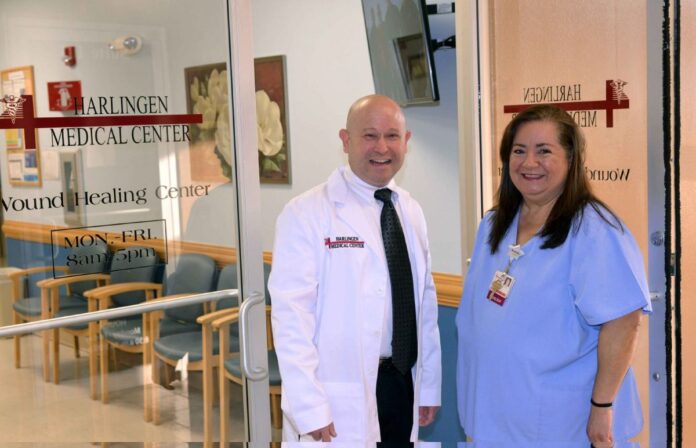HARLINGEN – For diabetes patients in the Rio Grande Valley, taking a few simple steps – such as checking their feet for abnormalities and seeking early treatment for any wounds – can save them from potential tragic complications, such as having to have an amputation of a foot or leg.
This was the message of Dr. Luis R. Venegas, DPM, ABPM, Podiatrist and Medical Director of the Wound Healing Center at Harlingen Medical Center. His message is particularly timely, considering that April is “National Foot Health Awareness Month”.
Dr. Venegas recommends that diabetics check their feet every day, using a mirror if necessary, to look for lesions, abrasions, abnormal calluses (thickened, hardened sections of skin), and other signs of trauma and infection.
If a diabetic is not able to clearly see the bottom of his or her feet, Dr. Venegas suggests asking a family member to check their feet on a regular basis for ulcers or other problems.
In addition, Dr. Venegas says it’s important for patients to check their shoes each morning, to make sure that a foreign object has not fallen into one of the shoes. Since many diabetics can’t feel sensation in their feet, they may walk around for days — not knowing there is an object in their shoe – whether it be a pebble or piece of metal, such as from a stapler.
“Once your feet become numb, it’s hard to tell if you have any injuries, or to feel something that may be damaging your foot,” Dr. Venegas said.
Even worse, once their foot is damaged, such a patient may lose the protection of their skin underneath their foot – making them prone to infections from bacteria, fungus and viruses, which could eventually lead to destruction of the tissue in their foot.
Complicating these problems even more is a high-cholesterol, high-fat diet, which can result in arteries becoming clogged – and reduce blood circulation in the feet and legs. Reduced blood circulation means it takes longer for the body to heal from an injury.
The consequences of not taking care of foot problems can be life-altering. Tragically, patients who must have a foot or leg amputated often become disabled, and in some cases, dependent for care on family members.
“A foot amputation can interrupt a patient’s whole life – including affecting their personal life and family life – and make them unable to return to work,” Dr. Venegas said. “This is why it is so important to have simple foot ulcers treated in a timely manner.”
Fortunately for such patients, the Wound Healing Center at Harlingen Medical Center offers some of the most advanced, comprehensive treatments available to help heal such injuries, starting with basic local care of the wound and if necessary including hyperbaric oxygen therapy. Dr. Venegas says the hyperbaric oxygen therapy (HBO) helps “in an incredible way” in many diabetic patients, by increasing the level of oxygen in damaged tissues.
“We are up-to-date with the latest technology in various treatment modalities, including using bioengineered tissue, such as tissues which are grown out of placenta cells or skin,” Dr. Venegas said. “These bioengineered tissues keep us a step ahead on treatment of these wounds … basically they help to shorten the duration of the wound. By shortening the wound duration, it helps make sure the person doesn’t develop further complications or deeper infections, such as infections of the bone, in many cases. Our goal is to close these wounds in a timely fashion, within 120 days in most cases.”
Additional treatments at Harlingen Medical Center include surgical treatment of wounds; skin grafts; wound “debridement,” which involves removing dead tissue and contaminated substances; and antibiotic therapy to stop infections.
In addition, Dr. Venegas said one of the main goals is to relieve pressure on the foot, which in some cases may require the patient to use special shoes or added padding on their shoe — or even to use crutches or a wheelchair temporarily, until the wound is healed.
Depending on the needs of each individual patient, other components of the treatment plan may include pain management, nutrition management, infectious disease management, physical therapy, nuclear medicine/radiology, vascular and laboratory evaluations, and diabetes education.




